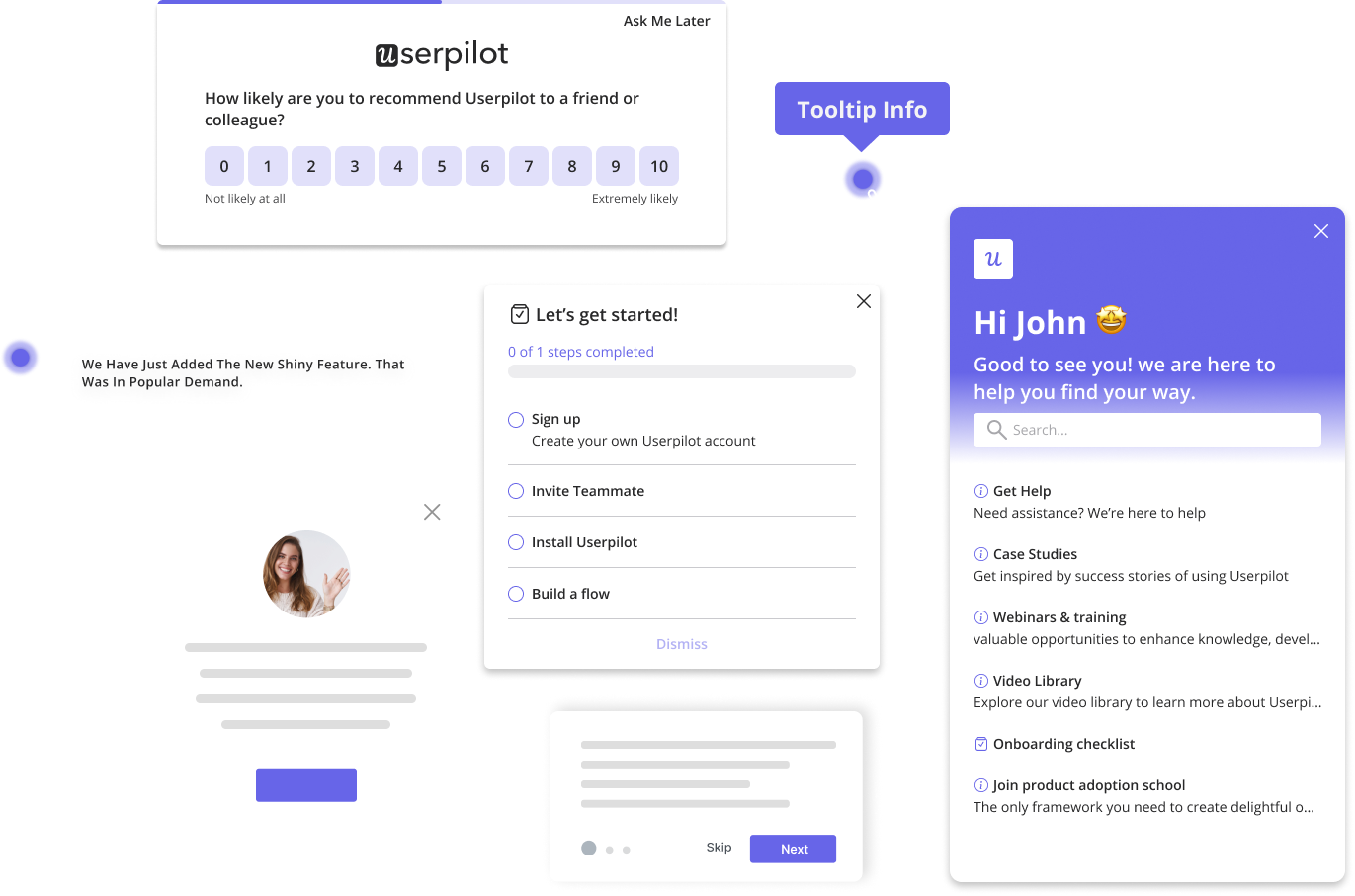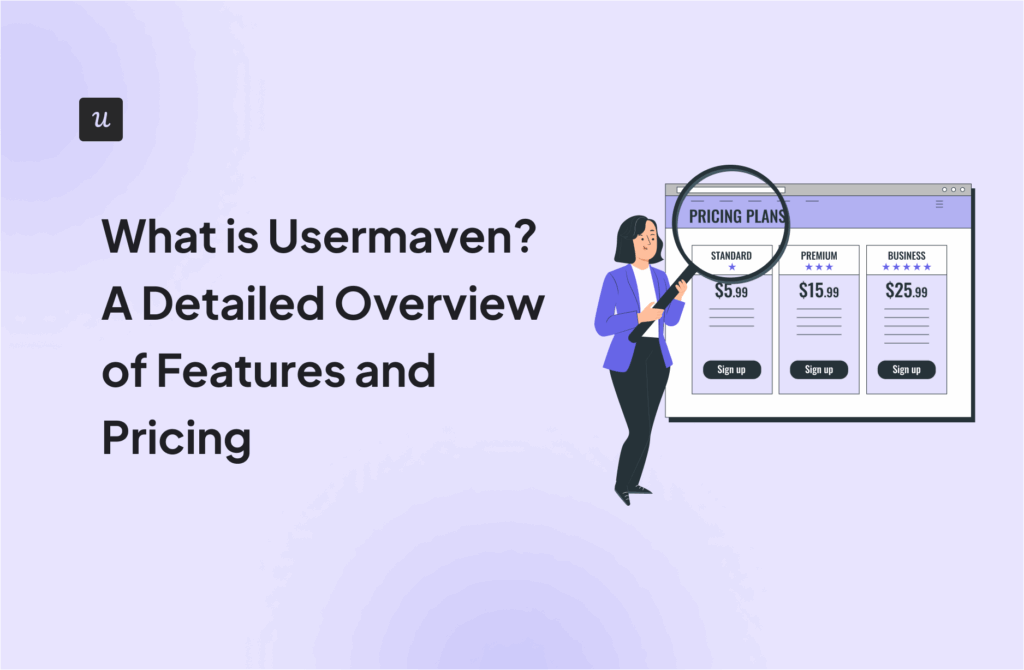
If you’re on a hunt for a digital adoption solution, the two industry heavyweights, Pendo and Whatfix, are likely already on your radar. Both offer powerful onboarding and engagement tools for large teams, but they come with their own set of frustrations.
Some Pendo users praise its sophisticated product analytics but get bogged down by the steep learning curve and limited customization for in-app guidance. On the other side, Whatfix often wins points for hands-on user walkthroughs, but users report that setup is complex, and product analytics isn’t as deep as they’d like. So, Pendo vs Whatfix, which offers the sweet spot for you?
This guide breaks down how the two compare across key use cases, where they fall short, and which scenarios they’re best suited for. If neither feels like the right fit, I’ll introduce Userpilot, a platform favored by lean, product-led teams for its speed, actionable analytics, and cost-effectiveness.
What is your primary goal when comparing Pendo and Whatfix?
Which is a bigger priority in your Pendo vs Whatfix evaluation?
What about budget and implementation speed?
Your Pendo vs Whatfix search might be over.
It looks like you need a tool that balances powerful analytics with flexible, code-free user engagement without the enterprise price tag.
Userpilot is designed for product-led teams who need to drive adoption efficiently—combining the best of both worlds without the complexity.
Try Userpilot Now
See Why 1,000+ Teams Choose Userpilot
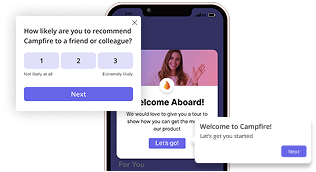
Overview of Pendo
Pendo is a software experience management platform that helps enterprises analyze and improve user interactions with their digital tools.
While Pendo primarily serves cross-functional teams of product managers, UX designers, and customer success managers at PLG SaaS companies whose goal is to improve user retention, it also works on third-party tools, and thus, can also be used for employee training as a secondary use case.
Here’s a detailed breakdown of its use cases and features:
- Onboard and provide continuous guidance to users: With the Pendo Guides module, you can build interactive walkthroughs using Pendo’s tooltips, modals, and carousels (for mobile).
- Analyze user behavior: With the Pendo Analytics suite, you can automatically capture in-app events or set up tracking for server-side events, then analyze product usage via customizable dashboards and analytics reports. Plus, Pendo’s session replays and heatmaps allow you to dig deeper and see the why behind the numbers.
- Gather direct user feedback: Trigger microsurveys that live inside Guides or send dedicated NPS surveys via in-app banners and emails.
- Drive product discovery and validation: Pendo allows users to submit feature requests and vote on them, and then their input can be fed directly into roadmaps.
Overview of Whatfix
Whatfix is a digital adoption platform (DAP) that helps enterprises accelerate software adoption and improve employee productivity. It is primarily aimed at large organizations undergoing digital transformation or managing complex software ecosystems, such as CRM (Salesforce), ERP (SAP, Oracle), and HCM platforms.
Ideal customers are typically in industries with extensive training needs, including healthcare, hospitality, and retail chains. Key user personas include customer success managers, product, and HR/L&D teams, who mostly use Whatfix for internal apps, though it can also support customer onboarding if needed.
- Train employees and customers: Using Smart Tips, Pop-ups, Beacons, and Task Lists, enterprises can guide users step-by-step through key workflows and tools. Self-Help widgets allow users to access on-demand help inside the product. Additionally, in-app content can be repurposed into multiple formats (PDFs, videos, slides) to support blended learning.
- Assist change management: With Mirror, organizations can create sandboxed simulation environments for practice, reducing errors and easing transitions during process changes.
- Track application usage and improve software ROI: Monitor how internal tools are being used across teams and departments to identify which ones are heavily utilized and which are underused or redundant. This insight helps IT and management optimize the software stack and reduce licensing costs.
An alternative digital adoption platform: Userpilot
If you want the power of Pendo or Whatfix without the enterprise hassles, like steep learning curve, complex setup, or bloated price tag, Userpilot is a great alternative.
Like both tools, Userpilot is a feature-rich platform that combines product analytics, engagement, and feedback features. But the experience of using it feels completely different as we’ve focused relentlessly on making our platform intuitive, flexible, and cost-effective.
Here’s what you can do with Userpilot:
- Create personalized onboarding experiences: Design interactive onboarding experiences using different UI patterns like modals, slideouts, tooltips, hotspots, and checklists. You can target these by segment and set up triggers based on user actions.
- Provide self-service help: With Userpilot’s customizable resource center widget, you can centralize interactive guides, FAQs, and video tutorials, empowering users to self-serve without leaving your product.
- Analyze product usage and user behavior: Automatically capture core events, then visualize user journeys with funnels, paths, and retention cohorts, and monitor key metrics with custom dashboards. Then, you can click on any specific data point inside the report and zoom in with session replays.
- Implement an omnichannel lifecycle strategy: Userpilot lets you orchestrate automated flows that keep users engaged across every touchpoint. From in-app nudges encouraging feature adoption, behavioral emails nurturing trial users, or a mobile push notification re-engaging dormant accounts, you’ll deliver coherent experiences that fuel long-term retention.
Pendo vs Whatfix vs Userpilot: Implementation and ease of use
Verdict: Userpilot
Pendo has a complex implementation process and a steep learning curve. Whatfix is also complex to set up, but it’s slightly more intuitive than Pendo. Userpilot, on the other hand, is both quick to set up and easy to use
Pendo’s implementation and ease of use
The product is fragmented, and you’ll have to configure its different modules separately. Full deployment may take your engineering team around 2-3 months, and even after that, you’ll still need some coding for maintenance, from tagging elements to passing metadata for segmentation. Users on review websites also often complain that guide creation can be slow and buggy, but more on that later.
Whatfix’s implementation and ease of use
You’ll need support from your engineering team for the setup, which can take a couple of months. After that, you can easily build flows using either a browser extension or their desktop studio. But the downside is that deep customization and branding will require custom CSS.
Userpilot’s implementation and ease of use
I’ve seen teams go live in a day with Userpilot! The interface is clean and intuitive. The best part is that our tool is truly no-code; you won’t need developer help beyond installing a one-time JavaScript snippet. We have many customers who can back our words up. Shelterluv, for example, moved from Pendo to Userpilot because the latter was too complex. In their words:
One of the biggest feedback the team had about Pendo was like, we just don’t know how to use it. And it’s hard to figure out. We don’t have the time to just like sit and read through everything to figure out how to use it. – Matthew Brown, Senior Customer Solutions Manager at Shelterlu
Pendo vs Whatfix vs Userpilot: User engagement and guidance
Verdict: Userpilot or Whatfix, depending on the use case
Pendo’s engagement layer is missing features and limits customization. Whatfix engagement features are better suited for employee onboarding. Userpilot is the most complete engagement platform for SaaS users.
Pendo for user guidance
- Pendo lacks essential engagement features: Not only does Pendo lack advanced features for multichannel engagement, such as mobile push notifications, but it also lacks industry-standard hotspots. All you get are interactive guides with basic UI patterns and emails.
- Many essential features are gated behind add-ons: For example, there is no option to create standalone checklists with Pendo; you can only embed them into the resource center or as a Task list in Guides, which is only available in Guides Pro. Auto-translation is only included on the most expensive Ultimate Plan or as an add-on, and even then, right-to-left languages are only partially supported.
- Pendo’s out-of-the-box customization options are basic: Gradient buttons or dynamic personalization with the user’s name or plan type requires custom code. You’ll need to edit global CSS or inject metadata blocks, since Pendo still relies on underscore.js for templating. Unlike other adoption platforms that let you drop user properties directly into content, you can’t even say “Hi [First Name]” in Pendo without developer help.
- Guide styling is a clunky process that involves switching between multiple panels and tabs: To apply a theme, you have to leave the Guides section and switch to the Themes panel, which opens the Visual Design Studio (VDS) in a separate tab. After styling your theme, changes don’t auto-apply to existing guides. You’ll need to open each guide individually, reapply the theme, and republish it, which is tedious at scale.
Source: Vendr.

Whatfix features for user guidance
- Whatfix offers a wider selection of UI patterns than Pendo: Whatfix offers hotspots and standalone checklists, both of which Pendo lacks. It also has wider app coverage: on top of mobile and web, it also works on desktop apps. Whatfix supports large-scale autolocalization to over 70 languages, including right-to-left.
- One standout employee engagement feature is Mirror: It’s a risk-free replica of production apps that allows employees to practice workflows before moving into live versions.
- But Whatfix isn’t sufficient for product teams that want to go beyond in-app guidance and run growth experiments: The platform is missing critical features for SaaS product teams, such as behavioral emails, mobile push notifications, A/B testing, and company-level segmentation. In other words, Whatfix is a “bonus add-on” to an employee training tool rather than a real user engagement solution. You’ll get fragments of value, but not the depth you need.
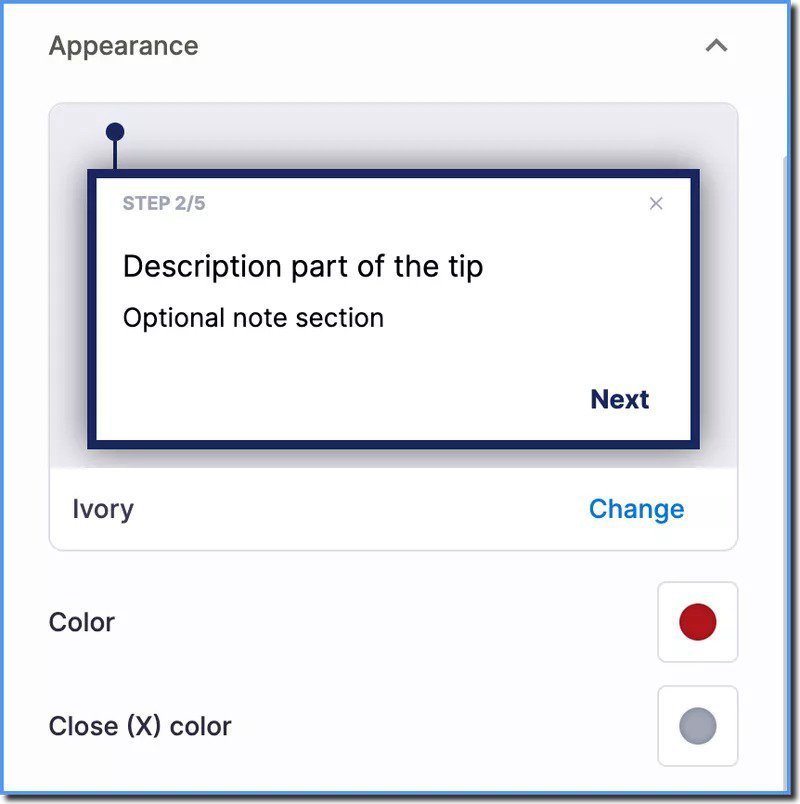
Userpilot for user engagement
Userpilot has all the tools product teams need to create omnichannel experiences, run product marketing campaigns, and growth experiments across the user journey.
- Userpilot’s in-app engagement features are superb: In addition to tooltips and modals, we also offer hotspots and standalone checklists, both of which Pendo lacks. For each UI pattern, there are dozens of readily available templates you can quickly customize.
- Userpilot is also the only platform in this list to offer mobile push notifications: These come in handy for omnichannel engagement, cross-marketing campaigns, and re-engaging inactive users.
- Our autolocalization feature supports 30+ languages, including right-to-left. Unlike Pendo, we have built-in dynamic personalization, which enables inserting dynamic variables into your in-app content directly and enables personalization at scale without coding.
- The interface is intuitive and unified, so you don’t have to constantly switch tabs: Whether it’s designing in-app onboarding flows, running product launch emails, or mobile push notifications for upsells, you can manage all your user communication from one dashboard and create cohesive user journeys across channels.
The only downside is that Userpilot doesn’t support third-party applications and employee onboarding use cases.
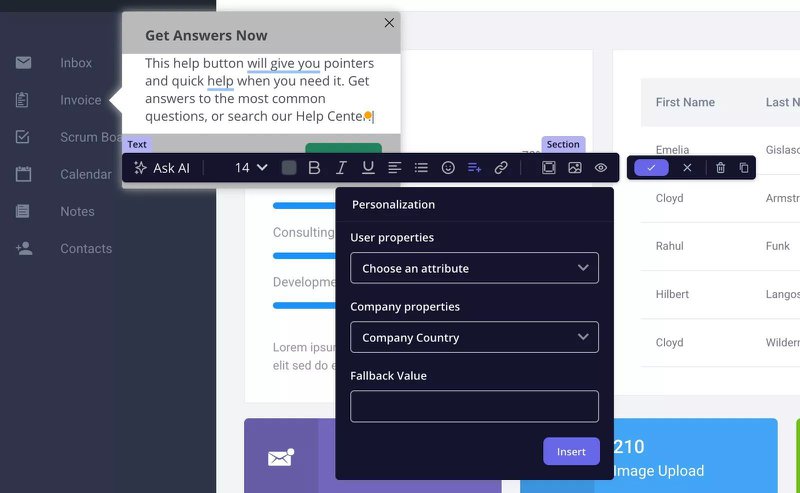
Pendo vs Whatfix vs Userpilot: In-app help center
Verdict: Userpilot or Whatfix, depending on the use case
Pendo’s resource center falls short on multiple fronts. Userpilot’s resource center offers sophisticated features for product and success teams. Whatfix offers powerful enterprise knowledge management features, but customization is limited
Pendo’s resource center
- You can embed external knowledge bases and flows, but video support is limited: You can’t play linked videos directly inside the app, and users will be redirected to another platform, which breaks user flow and creates friction.
- There is no general search functionality: You can only enable search inside individual modules, making it harder for users to locate the resource they need.
- But the worst part is that Pendo lacks search term analytics: This means you won’t be able to see what users look for most and the areas they struggle with. To add salt to the injury, only 1 RC per plan is included, unless you purchase the Ultimate plan.
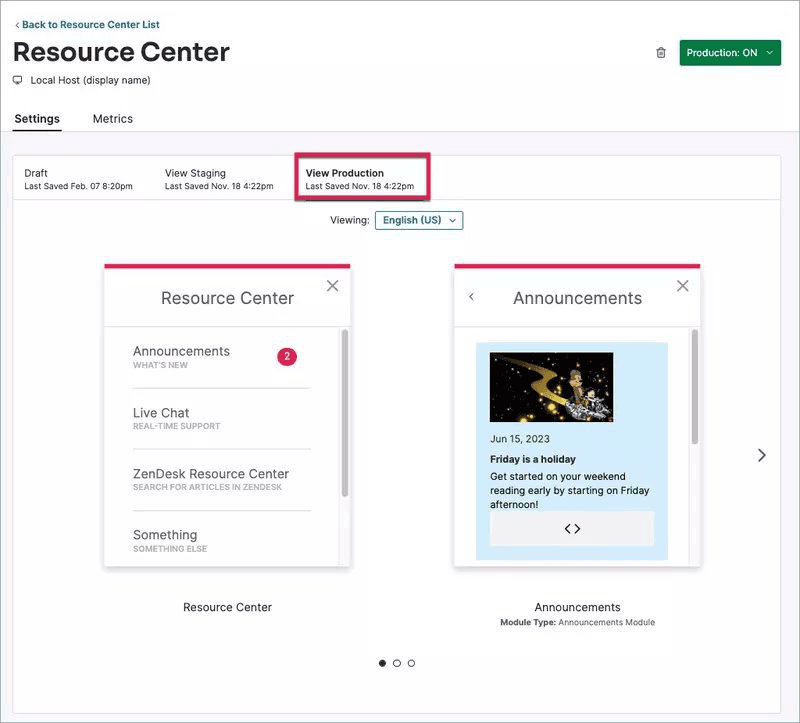
Whatfix’s resource center
- Whatfix integrates seamlessly with different repositories: Think knowledge systems like SharePoint, Confluence, Zendesk, Freshdesk, Salesforce, ServiceNow, and more. This makes it particularly useful in enterprise environments where help resources are scattered across multiple systems.
- The QuickRead feature uses AI to summarize search results: This allows users to get concise answers efficiently.
- However, it comes with notable limitations in regard to customization and targeting: Whatfix’s checklists, called Task Lists, cannot be embedded into the Self Help widget; they remain a separate feature. In addition, while you can target the widget to appear for certain users, you can’t target individual modules inside the widget with different rules.
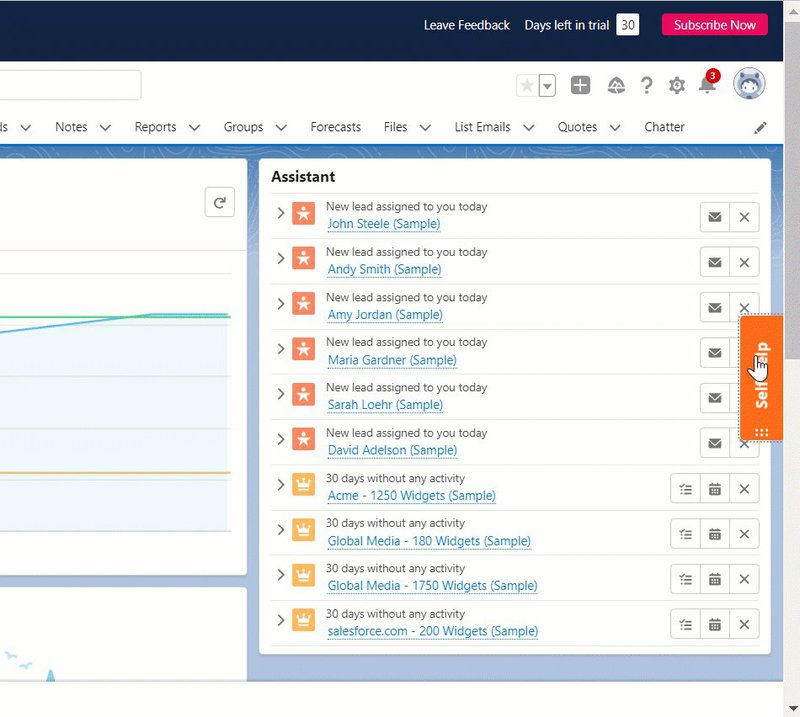
Userpilot’s resource center
Userpilot gives you unlimited help centers from the growth plan onward. Each is fully customizable to match your product’s look and feel.
- Unlike Pendo, Userpilot has full video support: Embedded videos play directly inside the app, keeping the user focused.
- Global search bar pulls results from both the resource center and linked knowledge bases: It’s easy for users to find help wherever it lives.
- Userpilot has search analytics: You can see exactly what users are typing, which queries return no results, and where knowledge gaps exist. I find this especially useful when trying to spot friction points and improve in-app guidance.
- Module-level targeting for a personalized self-service experience: You can control which content you would like to appear for specific users. For example, you can hide advanced feature guides for users only starting out to avoid overwhelming them, and only show getting-started resources in the help center.
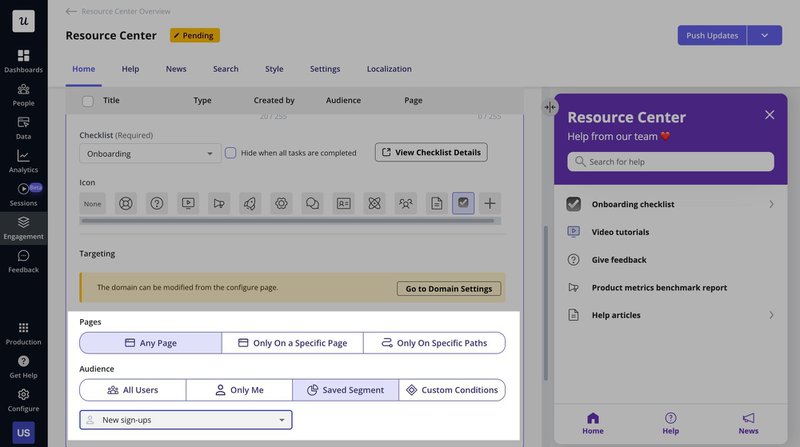
Pendo vs Whatfix vs Userpilot: Feedback collection
Verdict: Userpilot for the win if you want flexible surveys, Pendo if you want a centralized user feedback system.
Pendo surveys are basic, but its extra product discovery tools can make up for it. Whatfix’s feedback layer is basic, only good for employee-facing use cases.
Pendo for user feedback
- Pendo doesn’t have bespoke surveys: It offers Polls, which are a building block in guides. I should warn you, though, that the experience of using these is clunky; Guides only offer three survey templates, customization is limited, and the creation process isn’t intuitive.
- Separately, Pendo offers NPS surveys: You can send the NPS surveys in-app, add email distribution, or set up a mobile app survey. But this also comes at a cost: Pendo NPS is included only in Pendo’s two most expensive plans, and is a paid add-on for others.
- Pendo offers additional discovery and sentiment analysis features through the Listen module: Apart from roadmapping and idea validation functionality, Pendo Listen allows for centralizing customer feedback from different sources, including guides and NPS, manual forms (filled in by Pendo users), or CSV uploads. There is a dedicated Insights tab where you can get AI-powered summaries, visualize feedback volume, see which portions of feedback are associated with specific product areas, or review top submitters. Pendo Listen is included in the two highest-tier Pendo plans, and has to be purchased separately for other paid plans.
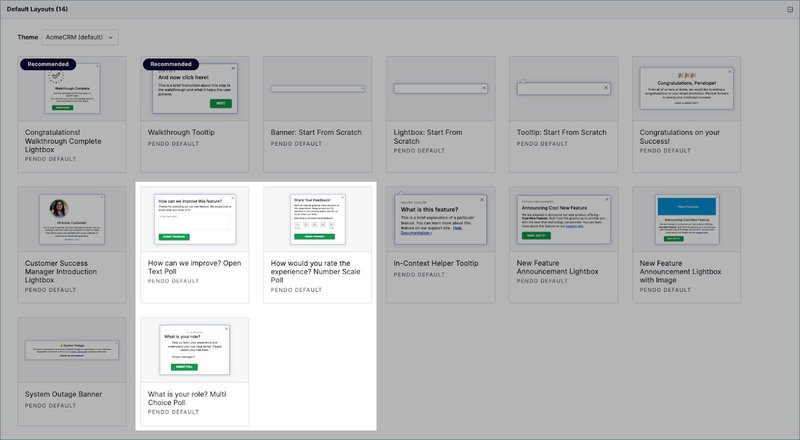
Whatfix for user feedback
- Collect in-app feedback via out-of-the-box surveys: You get NPS and usability questionnaires for evaluating training content.
- Surveys come with strict plan constraints: In the Standard plan, you can use these templates and edit the text, but you cannot add new questions or logic. Only Premium (and higher) plans unlock fully customizable surveys (unlimited questions, branching logic, AI‑driven analysis of responses).
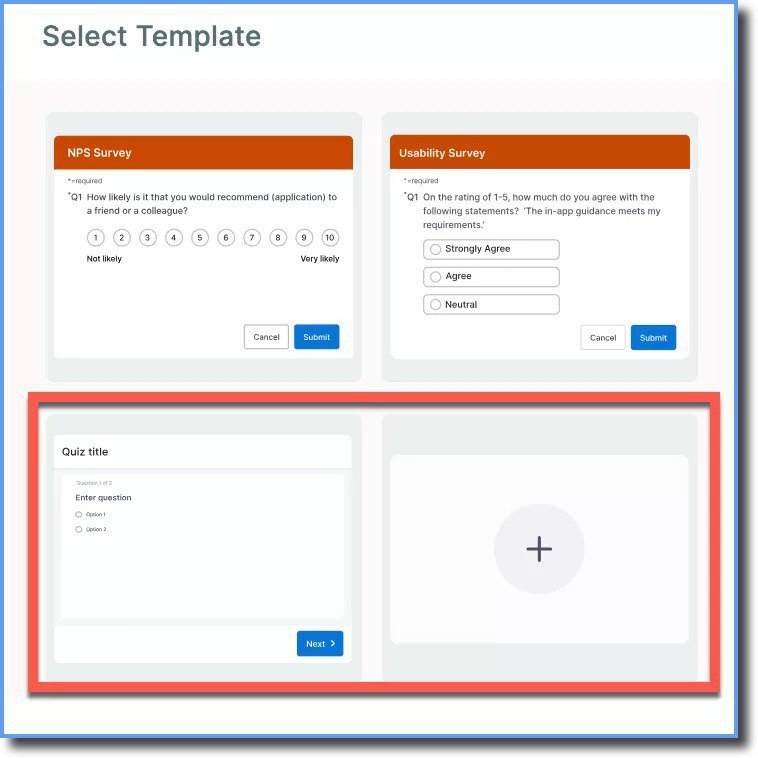
Userpilot for user feedback
- Create in-app surveys from over 30+ customizable templates: These include CSAT, CES, feature feedback, or product research. Designing them is intuitive and completely code-free!
- Get unlimited NPS surveys right from the starter plan: Even smaller teams can collect customer sentiment at scale without hidden costs. You also get a dedicated NPS dashboard and qualitative response tagging for analysis.
- Personalize surveys with advanced branching logic: You can adapt questions based on previous responses, starting from our Growth plan. As a reminder, on Pendo’s equivalent plan, surveys are static; you need to buy one of the highest-costing plans to get the same results.
- Easily cross-reference user feedback with product usage: Both qualitative and quantitative data live in the same dashboard, and you can link survey responses with behavioral analytics seamlessly, without extra setup or buying add-ons.
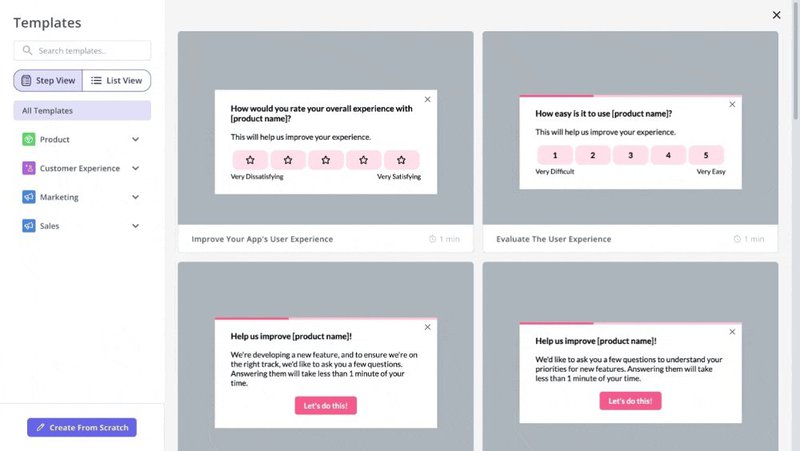
Pendo vs Whatfix vs Userpilot: Integrations
Verdict: Whatfix
Pendo integrations
Pendo offers an over catalog of 70+ native integrations. Any others must be purchased as add-ons. These are spread across CRM (Salesforce, HubSpot), support (Zendesk, Freshdesk), data platforms (Segment, Google Cloud Storage, Amazon S3), collaboration (Slack, Confluence), and more. But only one Pendo integration is included in the plan by default. The rest sit behind paywalls and need to be purchased separately.
Whatfix integrations
Whatfix provides the most extensive integration coverage. It works well with enterprise CRMs (Salesforce, Oracle), knowledge bases (Confluence, SharePoint), support platforms (Zendesk, Freshdesk), HRIS and LMS tools (Workday, SuccessFactors), and analytics software (Power BI, Amplitude, Mixpanel).
Userpilot integrations
While Userpilot has fewer integrations than Pendo and Whatfix, we win in practicality. All integrations are available out of the box on our Growth plan. Userpilot integrates natively with tools like Segment, Mixpanel, Amplitude, Heap, HubSpot, Intercom, Salesforce, Zendesk, and Google Analytics. It’s enough for most product teams, especially those focused on external user onboarding or customer experience.
Pendo vs Whatfix vs Userpilot: Customer support
Pendo’s customer support
Pendo offers support via a chatbot, a Slack community, and its notorious Academy. But none of the plans include a dedicated customer success manager; you’ll need to buy the Premium Service package separately if you need personalized support. And considering how complex Pendo is, you’ll most likely need to invest in this.
Whatfix’s customer support
Users can reach out either via email or in-app chat if they need real-time assistance. In fact, Whatfix’s support team operates 24 hours a day, five days a week, ensuring that users can receive assistance during business hours. Users consistently commend Whatfix’s customer support for its responsiveness and effectiveness. One reviewer on G2 noted, “Customer Support is amazingly responsive to resolve issues.” On top of that, Whatfix pairs users on all plans with a Named Customer Success Manager, who hand-holds and guides them through the entire process
Userpilot’s customer support
Userpilot includes chat and email support across all plans. I’ve seen teams appreciate the level of attention they get, even with fewer monthly active users. You get access to a self-service knowledge base, in-app guidance, and in many cases, live sessions or onboarding help from day one. Most teams, especially small to mid-sized teams, focused on product adoption find this support both proactive and genuinely helpful, without needing to step into enterprise service tiers.
Pendo vs Whatfix vs Userpilot: Pricing
Verdict: Userpilot
Both Pendo and Whatfix have complex pricing systems and can accumulate costs quickly. Userpilot is the most cost-effective.
Pendo pricing
Pendo’s pricing isn’t transparent, but from what I’ve witnessed on review platforms, I can tell it’s complex, expensive, and add-on dependent. According to Vendr, plans range from $15,000 to $142,000/year, with the average around $48,000. Costs depend on MAUs, features, and plan tier.
I’ve seen several G2 reviews from teams that liked Pendo’s potential but felt blindsided by how quickly costs accumulated. Core features like localization or analytics are locked behind higher plans or paid add-ons. Renewals often come with a 5–20% uplift.
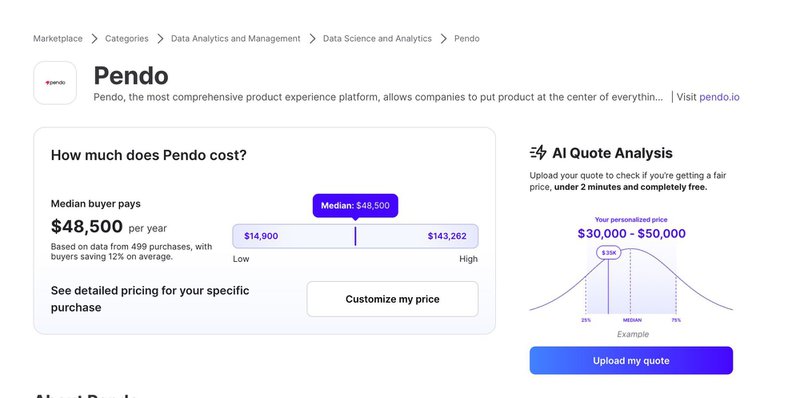
Whatfix pricing
Whatfix pricing is also quote-based. It charges per application, per user type, and locks essential features behind higher tiers. Based on buyer reports, Whatfix costs $25,390–$38,766/year, with setup fees ranging from $5,000 to $20,000.
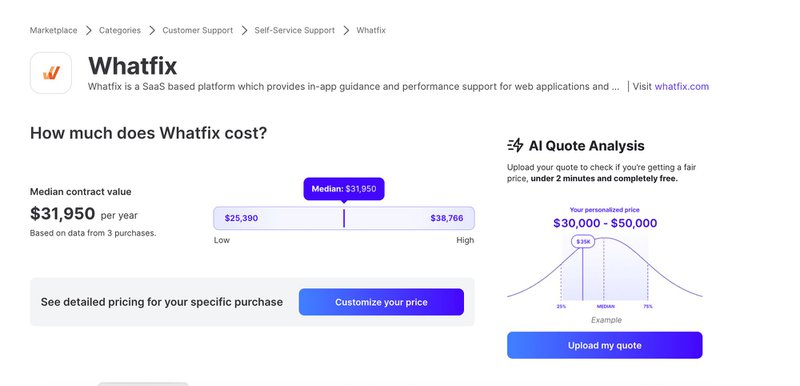
Userpilot pricing
Userpilot pricing is transparent. Our cheapest plan starts at $299/month for up to 2,000 MAUs, and our most popular, Growth plan offers customized pricing. Most features are included by default (except for session replays and mobile support), and there are no renewal fees. You get good value for money, as evidenced by our customers at Cuvama, who switched from Pendo:
High price was one of the decision criteria to move from Pendo because we were paying lots, and we were not using it. With Pendo, I could not do, or at least I didn’t know how to easily do, specific flows for specific companies. Because Userpilot is easier to configure and to work with, I’m getting much more value than with Pendo. – Leyre Iniguez, Customer Experience Lead
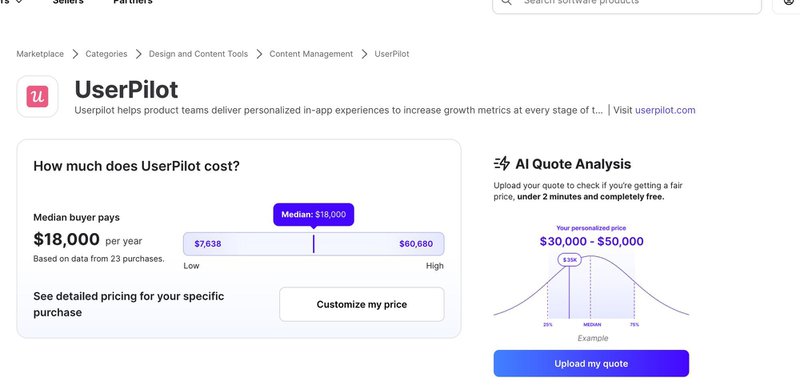
Pendo vs Whatfix vs Userpilot: Which tool should you choose?
Choose Whatfix if:
- You are an enterprise company operating in a multi-app environment, managing internal tools across web, desktop, and mobile.
- You are mainly looking for employee onboarding and digital transformation.
- You have dedicated IT, HR teams, and resources to handle maintenance.
Choose Pendo if:
- You are an enterprise company that needs a tool for mostly user onboarding and has a secondary use case for employee onboarding.
- You also need roadmapping and product discovery tools.
- You have a dedicated analytics or operations team to configure and maintain the tool.
Choose Userpilot if:
- You are a growing company or enterprise that needs a product growth platform.
- You are a product-led company that wants simplicity without sacrificing functionality.
- Your team has limited technical resources, so it needs a truly no-code solution.
Book a demo to get started. If you’re coming from Pendo, we offer a special discount.
DISCLAIMER: Userpilot strives to provide accurate information to help businesses determine the best solution for their particular needs. Due to the dynamic nature of the industry, the features offered by Userpilot and others often change over time. The statements made in this article are accurate to the best of Userpilot’s knowledge as of its publication/most recent update on September 10, 2025.

